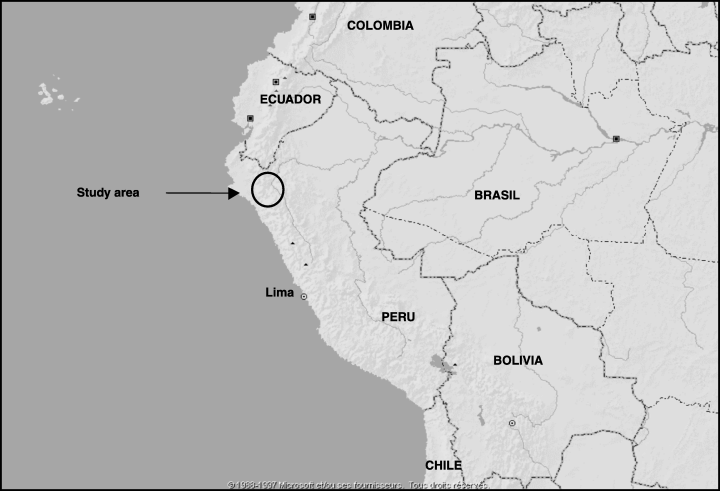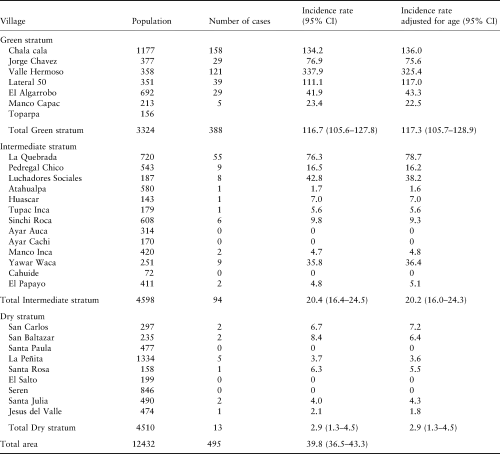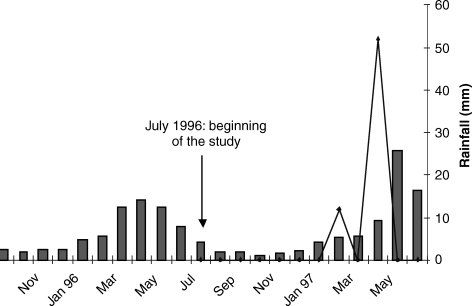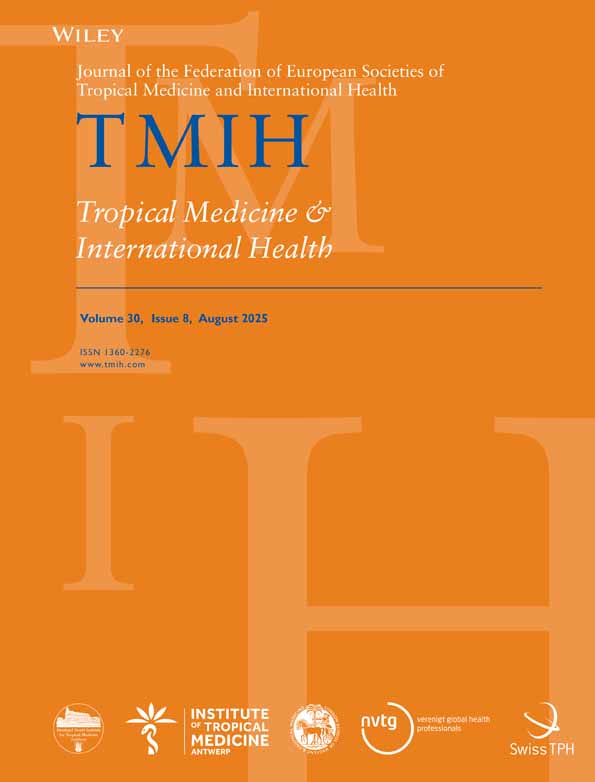Environmental factors as determinants of malaria risk. A descriptive study on the northern coast of Peru
Abstract
We conducted a series of studies on the northern Pacific coast of Peru to determine environmental risk factors for malaria. We report in this paper the results of both a descriptive study of incidence and a prevalence survey of malaria. Both studies showed that the area was at low risk for malaria. The malaria incidence rate was 40/1000 p.a. during the study period, and the prevalence of infection was 0.9% (95% CI: 0.4–1.7) before and 1.4% (95% CI: 0.8–2.2) after the high incidence period. However, the risk of malaria varied according to season, village and even house within a single village. Incidence rates increased from February (2.6/1000 p.a.) to May (12.9/1000 p.a.) and decreased during the second part of the year. Most of the cases were clustered in four villages that constituted only 21% of the total population of the area. Houses where multiple cases were recorded were often located near a source of water. Our observations suggested that environmental factors, and particularly the presence of water for irrigation around villages and houses, played a major role in determining the risk of malaria. These observations were extended through an entomological study and a case–control study, to be published elsewhere.
Introduction
Malaria is an important health problem of developing countries, especially in tropical Africa where about 1 million deaths and just over 200 million episodes of clinical malaria occur each year (Snow et al. 1999). However, even if its magnitude and impact are far less than in Africa, malaria is also a problem in Latin America where 1 138 966 cases (confirmed by a positive blood slide) were reported to the Pan American Health Organization (PAHO) in 1996 (PAHO 1997). Moreover, the disease is affecting areas that have been previously free from malaria, and is becoming more severe as a consequence of the increasing incidence of Plasmodium falciparum infections (PAHO 1992, 1997). As for most of the affected countries in the continent, the malaria situation in Peru has also deteriorated in the last 20 years (PAHO 1990, 1993, 1995, 1996; PAHO–WHO 1992). The number of reported cases remained relatively stable between 1975 and 1980 (about 14 000 cases p.a.). In 1985, this number had more than doubled (35 026 cases) and remained stable until 1990 (between 32 000 and 40 000 cases each year). The greatest increase was seen between 1990 and 1996 when the number of cases increased sixfold, from 33 705 reported in 1991 (PAHO–WHO 1992) to 162 200 in 1995 (PAHO 1996) and 208 543 in 1996 (PAHO 1997). While Peru only reported 3% of all the cases on the continent in 1991 (PAHO 1992), this proportion was 11% in 1994 (PAHO 1995), 12% in 1995 (PAHO 1996) and 19% in 1996 (PAHO 1997). These figures may partly be explained by improved case detection and reporting in Peru during the 1990s. However, the size of increase suggests that the malaria situation has truly deteriorated.
Malaria in Peru mainly affects the area of tropical rain forest, particularly Loreto Region, that reported 51% of all cases reported in the country in 1996 (PAHO 1997). However, cases have also increased along the Pacific coast, particularly in the Grau northern coastal region of the country (PAHO 1992). Unlike most of the malarious areas of the country, this region is a dry coastal region affected by seasonal malaria during the months of agricultural activity. This region reported 50 985 cases of malaria in 1994 (PAHO 1997) and 39 708 cases in 1995 (PAHO 1996), the year before our study began. These figures represented 50% and 25% of the total cases reported in the country, respectively. The first six cases of falciparum malaria were detected in this region in November and December 1992 and since then, P. falciparum infections have increased every year: 5782 cases in the last 6 months of 1994 and 18 419 cases in 1995 (MOH, unpublished).
In view of this, a series of studies was conducted between May 1996 and June 1997 to better understand the local malaria situation in this area of the country. This paper reports the results of the studies of descriptive epidemiology of malaria in the study area.
Methods
Study area
The study was carried out in Tambogrande and Bellavista Districts, Sullana Province, `Luciano Castillo Coloma' Sanitary Area, one of the three sanitary areas of Grau Region (Figure 1). Its head office, reference laboratory and main hospital are at Sullana, the largest town of the area. There are four health posts in the study area, located in the villages of Sinchi Roca, La Peñita, El Papayo and Chalacala. At each health post, a malaria technician is responsible for the Malaria Programme in his area. In some communities, a malaria volunteer occasionally helps. People in the villages know that fever can indicate malaria so that when somebody suspects that they may have the disease, they may go to the volunteer's house to have a blood smear, walk to the health post or the laboratory, or wait for the malaria technician's house visit. Slides are read at Sinchi Roca's Laboratory or at Sullana. Results are reported to the reference laboratory at Sullana where a sample of slides is re-read by a second lab technician.

The study area.
The study area, located 140 m above sea level, is composed of 29 villages. There is a seasonal pattern in the region which is constant over the years. During the study period, relative humidity decreased steadily from a maximum of 81% (July 1996) to a minimum of 64% (March 1997) and then increased to 72% in the following months. Average monthly temperatures rose from 19.5 °C in July 1996 to 27.0 °C in March 1997 and remained fairly constant in the following months. The annual rainfall was 64 mm during the 1 year study period, and there were two hard and short rains in February 1997 (12 mm) and April 1997 (52 mm). Therefore, weather is hot and rainy during the first half of the year and then becomes cooler and more humid but with no rainfall during the second half. Water is brought from two barrages both situated to the north of the area. Irrigation is intermittent and depends on the crop and the period of the year. Frequency of irrigation also depends on the level of water in the barrages. People live in small villages of around 60–250 houses, usually connected by unpaved roads. Houses are in most cases concentrated, but they can also be dispersed, and then generally located near the fields. Houses are built primarily of regional materials. Walls are made of adobe (bricks of mud and straw), wood covered sometimes with mud, brick or sometimes banana or maize leaves; roofs can be made of tile, corrugated iron, cement sheets or straw. There is no running water, no sewage system and no electricity, although people use car batteries to listen to the radio or watch television.
At the beginning of the study villages were classified into three ecological strata on the basis of the likely proximity of mosquito breeding sites. These strata consisted of villages located in dry areas, usually located 30–60 min walk from the fields and raised up above the fields – the dry stratum; villages in dry areas surrounded by cultivated fields – the intermediate stratum; and villages where houses were usually scattered amongst the fields and near canals – the green stratum. The majority of people in the area are small farmers. Subsistence farming is supplemented with animals, generally a few goats. The main crops are cotton, fruit (lemon, mango, and papaya) and maize. Rice is also planted near the villages of Valle Hermoso, La Quebrada and Chalacala. The main agricultural season starts in December when people prepare the fields.
Census of the population
A initial door-to-door census of the population was performed. If nobody was present in the house (because adults were in the fields and children at school), the house was re-visited twice until somebody was there. If the house was unoccupied (temporary migration or house definitely abandoned), or if nobody was present in an inhabited house after several re-visits, the house was recorded as empty. A map of each village was drawn with the main reference points and each house identified by a number.
Consent
The study was authorized by the Ethical Committee of the Department of Scientific Research, Cayetano Heredia University, Lima. Additionally, written community consent was requested from the authority of each community.
Recording malaria cases
Malaria data were collected by two means. First, we performed a retrospective analysis of data recorded in the four health posts of the study area during the 2 years prior to the study (no information was available, however, for Chalacala and El Papayo health posts for the period January 1994 to December 1994). Information on sex, age, species, parasite densities, community of residence and date of diagnosis was available for each malaria case diagnosed in each of these health facilities. Secondly, an active case detection system of malaria cases was set up after the beginning of the study, based on a malaria village volunteer present in each village of the area. This system allowed us to collect information during the entire study period. The role of the malaria volunteer was, through weekly house-to-house visits, to detect people in the village with malaria symptoms, to take a blood sample, to carry the sample to the laboratory of the area and, if positive, to administer antimalarial drugs according to the government's protocol (chloroquine + primaquine for vivax malaria, chloroquine and sulfadoxine/pyrimethamine as the second-line drug for falciparum malaria). As payment for this contribution to the study (and to malaria surveillance), each volunteer received the equivalent of a daily salary for working in the fields. The work of the malaria volunteer was supervised by a malaria technician, who supplied him with materials, recorded the cases and reported them to the health authorities in Sullana. Slides were re-read by a second lab technician in the Reference Laboratory in Sullana. According to the 1996 statistics in the Health Area, the rates of false positive and false negative slides for malaria in the whole area were, respectively, 3.8% and 0.6%. From the 10 563 positive slides re-read in the Reference Laboratory in 1996, 114 vivax slides were truly falciparum and 95 falciparum were truly vivax (Ministerio de Salud, unpublished data). Since the study period was July 1996 to June 1997, we present the descriptive epidemiology of malaria for that period and for the 2 years prior to the study: July 1994 to June 1995 and July 1995 to June 1996. Cases of malaria diagnosed during the study period were plotted on a map in each of the villages, to show the spatial distribution of malaria cases within each village. This was not done for the total number of cases diagnosed during the year of study, but only for the 323 cases recorded in the study area between 1 July 1996 and 30 April 1997, which were included in a case–control study performed during that year (Guthmann et al. 2001).
Measuring prevalence of malaria infection
Two surveys were performed to quantify malaria before and after the rainy season. A spleen and a blood examination were carried out on each subject. Sample size calculations were done using EpiInfo. No data about the prevalence of malaria parasitaemia in the area were available. Using an estimate of 6% (precision: 3.5%), 3% (precision: 2%) and 1.5% (precision: 1%) of infection, respectively, in the green, intermediate and dry strata during the dry season, we considered that the number of people required in each of these strata was, respectively, 194, 262 and 504 individuals. Taking into account census data which indicated an average number of five persons per house, the number of houses to be visited was 40, 50 and 100, respectively, in each ecological stratum. The same figures were used for the second survey in June. A simple random method was used to select the houses to be visited, using the list of houses produced by the census. Selection of houses was done separately for each ecological stratum using a table of random numbers. The sampling unit was the house, and the sampling frame was the list of all the houses of the stratum which were numbered (the list of houses was available from the study census). The spleen rate was calculated as the proportion of people with enlarged spleens in the sample. The parasite rate was calculated as the proportion of positive slides in the sample. Specific (sex, age, ecological strata) parasite rates were calculated and statistical tests (χ2) were performed to examine significant differences between these groups.
Laboratory diagnosis
Slides were read by a trained technician, currently working for the Malaria Programme, in one of the laboratories of the area. Thick films were used if the species was uncertain when the thin film was examined. A sample of slides was re-examined at the Reference Laboratory of Sullana.
Results
The census included 2273 houses, 99 (4%) of which were unoccupied. The total number of people living in the study area was 12 432, which yielded an average 5.2 persons per house. There were 52% males in the total population. The age distribution of the population was: 714 (5.7%) people aged > 60 years, 6452 (52%) aged 15–60 years, 3286 (26.5%) aged 5–14 years, 1455 (11.7%) aged 1–4 years, and 314 (2.5%) children younger than 1 year (2.5%). Four hundred and ninety-five malaria cases were diagnosed in the study area during the year of study (Table 1). The incidence rate in the study area was 40/1000 p.a.; higher in males (42/100 p.a.) than in females (39/1000 p.a.); however, this difference was not statistically significant (P=0.41). The incidence rate was higher both in people aged 5-year-old or above compared to the `under five group' (P < 0.01), and for vivax malaria compared to falciparum malaria (P=0.02). The incidence rate was globally higher in the green stratum than in the intermediate stratum (P < 0.01), and in the intermediate stratum compared to the dry stratum (P < 0.01) (Table 2). However, some heterogeneity was found within strata, with villages in the intermediate stratum (such as La Quebrada) having rates that were closer to that of villages in the green stratum. Incidence rates varied throughout the year, with a maximum in May after the short rains in April (Figure 2). The seasonal pattern of malaria incidence was similar to that of the two previous years. Cases of malaria were often clustered within the same house: 183 cases (56.3% of the cases plotted on a map) came from houses where at least one other case had been diagnosed. In most of these, the number of cases was small (two or three); however, in one house of Valle Hermoso nine cases of malaria were recorded at different periods within the year, and in one house this number was 11 cases. Ten slides of 1044 (prevalence rate=0.9%, 95% CI: 0.4–1.7%) and 19 slides of 1354 (prevalence rate=1.4%, 95% CI: 0.8–2.2%) were positive during the first and second prevalence studies, respectively (Table 3). These rates were not statistically significantly different (P=0.42). In both surveys, most of the infections were asymptomatic (9 of 10 and 16 of 19 in the first and second surveys, respectively). The parasite rate was higher in under-fives than in older individuals in both surveys, but these differences were not statistically significant (P=0.9 and 0.6, respectively). The prevalence rate was highest in the green stratum, but this difference was only statistically significant in the second survey (P=0.02). The number of people with an enlarged spleen was 15 of 1044 in the first survey (spleen rate= 1.4%, 95% CI: 0.7–2.1%) and 33 of 1354 in the second survey (spleen rate = 2.4%, 95% CI: 1.6–3.3%). These spleen rates were not statistically significantly different (P=0.12). One final finding of our study was that mortality because of malaria was very low with no malaria deaths recorded during the study period in our study area (Ministry of Health, Sullana, data not available).



Incidence rates (per thousand) (bar chart) and rainfall (mm) per month in the study area (combination of retrospective data from health posts (July 1994 to June 1996) and active case detection (July 1996 to June 1997). Rainfall was only recorded for the study period (source: Laboratorio de Fisica Universidad de Piura).
Discussion
This area had been regarded as at high risk of malaria. Indeed, the incidence rate in the study area 2 years prior to fieldwork was 123/1000 p.a., similar to that of other highly endemic areas of the country, such as the forest region of Loreto (Aramburu Guarda et al. 1999). This level of incidence is also comparable to other Latin American countries, such as Suriname, one of the most endemic countries in the continent (PAHO 1997). However, during the year prior to the study (1995–96) and during the study period (1996–97), the incidence rate of malaria was only 42/100 p.a. and 40/1000 p.a., respectively. The main explanation for this is probably the sharp decrease in rainfall after the strong rains of 1992–93 (`Mild El Niño'). In 1994, 1995 and 1996, annual rainfall decreased to 51, 6.9 and 2.2 mm, respectively, reducing natural water reservoirs and availability of water for irrigation. During our study period, rice was often replaced by other crops such as cotton or maize, because stocks of water in the San Lorenzo and Poechos dams were considerably lower than in previous years.
The age/sex distribution of incidence indicates that transmission was primarily peridomestic. A major factor determining risk was the season of the year; high risk was during the first months of the year, and then decreased sharply. This increase in risk observed during the first months of the year but mainly in April and May after the rains, is related to the presence of a large number of breeding sites for Anopheles during this period, when rainfall becomes more abundant and water for irrigation is released from the barrages and used for farming. An entomological survey performed during the study period showed that rice fields and drains were the most important breeding sites for Anopheles mosquitoes, and that Anopheles albimanus was the major potential malaria vector in the area (J-P. Guthmann, unpublished observations). The seasonal variation of malaria was investigated further through the two malaria prevalence surveys, which showed that both spleen and parasite rates, although very low and not statistically significantly different, increased after the rainy season and the period of agricultural activity. The low spleen rate and parasite rate allowed the classification of the study area as hypoendemic for malaria (Gilles & Warrel 1993). A surprising finding of this prevalence survey was that most infections were asymptomatic, which is not the current pattern in areas of low transmission where people are not immune. A likely explanation could be that these people were not symptomatic at the moment of the survey, but had presented fever in the previous days or weeks, which was not fully investigated.
The second major factor determining the risk of malaria was the village of residence and the ecological setting where this village was located. Some villages were at high risk, such as Valle Hermoso and Chalacala, which accounted for more than one half of the cases in this area (although concentrating only 12% of the population), whereas many of the villages located in the dry area had no cases at all. In these dry areas, villages were usually far from the fields and far from the canals, and therefore people were less exposed to the Anopheles bite, whereas green villages were often located near water reservoirs usually suitable for Anopheles breeding, and where house densities of Anopheles were usually high. It was striking that the risk of malaria by village was correctly determined by a relatively superficial inspection of villages at the beginning of the study. This has significant implications for the targeting of malaria control measures.
A third factor explaining the variation of malaria risk within the study area was the place of the house within a village. Cases were often clustered within the same house, which was often located near an Anopheles breeding site, and therefore people within that house were more exposed to the vector bite. Another explanation for this uneven distribution of malaria cases by house is the efficiency of use of protective measures. In several houses, it was observed that several children used to sleep in the same bed, bednets were in poor condition and windows were not protected with a net. One limitation in the interpretation of the spatial distribution of cases is, however, that only 323 (65%) cases of the 495 recorded during the study period were plotted on a map. These represented the cases diagnosed during the first 10 months of the study that were included in a case–control study (Guthmann et al. 2001). Therefore, these findings have to be interpreted with some caution, as the spatial distribution of the remaining 172 cases is not known.
The low malaria case–fatality rate was not unexpected, although the precise reasons for this is not clear. It is possible that a less pathogenic strain of P. falciparum is present in the area but more likely the early detection and treatment of cases limits mortality.
Conclusion
Our descriptive study showed that, for a person living in this coastal region of the north of Peru, the risk of malaria was related to three major factors: the season of the year, the location of the village within the area and the location of the house within a village. The results suggested that the presence of water for irrigation played a major role in determining malaria risk. Relatively superficial examination of villages permitted risk categorisation – this has important implications for targeting malaria control activities in these areas.
Acknowledgements
This research received financial support from the UNDP/World Bank/WHO Special Programme for Research and Training in Tropical Diseases. Thanks to the `Subregion de Salud Luciano Castillo Coloma' (Sullana), for their help during the study, especially M. Pablo Gutierrez and his team of field workers, Dra Eunice Munoz and Dr Alex Paucar from Tambogrande Health Centre. Many people contributed to the success of the study. We would like to thank particularly M. Marcelino Yucra and M. Hugo Benito for reading the slides, and M. Rene Cruz for his contribution in malaria surveillance and the recording of cases. Many thanks to all the village malaria workers of the study area and to the mayors of the villages, particularly to M. Jose Chero, who gave us permission to work in their villages and who helped us whenever necessary. The principal investigator is grateful to Cayetano Heredia University (Lima), The Chadwick Trust (London) and the French Embassy (Lima) for their help in Lima for their financial support, to the `GEL group' (IMTA A. Von Humboldt) for all their help in Lima, and to Julio Monge, Alberto Boyer and Dr Pablo Campos for their help when we arrived at Piura. Many thanks to Jo Lines at the London School of Hygiene and Tropical Medicine for his interesting comments and enthusiastic support.





